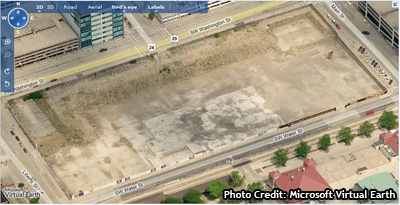You may recall that District 150, despite having just borrowed $30 million in tax-anticipation warrants at the beginning of the year to make payroll, is already running out of money again and needs to borrow $35 million more. This time they would raise the money through working cash bonds which will be repaid via property taxes over the next several years. Here’s the rub:
If 10 percent of voters petition the district to take the sale of the cash bonds to referendum, the district would run into a wall, having to wait until November, or plead with a judge to hold a special election, [interim controller Norm] Durflinger added.
Hopkins says “some people are now looking at this petition option.” “It could be a bargaining chip to stop future school closings, or could be affirmed on its own,” or it could be a way to get District 150 “management” to “resign in shame,” she says.
My take: When I first heard about this idea (of forcing a referendum on the bonds), I have to say, it didn’t thrill me. First of all, public schooling is an essential service and should be funded. Secondly, I just finished waging an unsuccessful effort to defeat the public facilities tax referendum, and I just don’t have the energy to do that again (so soon, at least). Thirdly, I have a hard time getting over the irony of museum tax supporters like Hopkins suddenly getting all concerned about wasting tax dollars. Apparently throwing $40 million down the drain on a museum is okay, but $35 million to pay teachers is unacceptable.
However, the more I think about it, the more I think forcing a referendum may not be such a bad idea. Why? Consider:
- They have been eluding voter accountability long enough. When District 150 wanted to build new schools, the money for that building program should have been submitted to the public via referendum. But it wasn’t. District 150, with the help of our state legislators (including then-state representative Schock) got legislation passed allowing District 150 to access the Public Building Commission for its building program, bypassing the voters and allowing them to raise our property taxes without a referendum. Practically speaking, this also meant they didn’t have to have public buy-in on the siting and design of the new school buildings.
- They have passed up other potential revenue. District 150 could have supported other school districts in the county and forced a 1/4% sales tax referendum onto the April ballot that, if passed, would have helped all county school districts get money for infrastructure needs, but they didn’t. District 150 officials won’t speak on this topic for attribution, but privately say that the reason they didn’t support this was because (a) they were asked not to by museum supporters such as Caterpillar and the Peoria Area Chamber of Commerce, who you may recall sent letters to all the school districts pressuring them to keep this off the ballot so it wouldn’t jeopardize the museum tax from passing, and (b) they didn’t want a new revenue stream right before they negotiated a new teachers contract because they thought it could lead to demands for higher pay/benefits. Hey, if they’re looking for ways to avoid getting more revenue, maybe they would favor forcing the bond issuance to a referendum.
- More money won’t resolve the root problem: mismanagement. We’ve been through this kind of crisis once already. We’ve already closed schools so that District 150 could allegedly get their fiscal house in order. Why are we going through this again — and so soon?
- It is not just because of revenue shortfalls. This crisis is often explained as merely a revenue problem — that everything would be hunky-dory if it hadn’t been for the recession or reductions in state aid. That would be believable except that no other school district around here is in quite the crisis as District 150. For example, Pekin’s school district actually has a surplus. While their FY08 budget does have a planned deficit built into it, it’s covered not by loans, but reserves that have been saved up over several years — most recently FY07.
- Savings from last round of closures were squandered. In 2007, District 150 closed White and Blaine-Sumner schools. However, they didn’t sell Blaine-Sumner, but remodeled it (including adding air conditioning) and turned it into district offices for about 80 workers. They did eventually sell the White School building for $750,000, but they also acquired the former Social Security Administration building on Knoxville and spent $1.27 million to remodel it to house their “transition to success academy.” Is it really any wonder that the district was unable to put up a surplus and save for a rainy day?
By and large, we still have the same management team in place now as was in place then. If they were unable to properly manage the last crisis, why should we have any confidence that money given them this time will be any better managed?
From what I’ve heard, the worst that could happen if a referendum is forced is that the referendum could fail, the district could become insolvent and be taken over by the state or, possibly, the city. I’m beginning to think that’s not such a bad outcome. Small changes in the makeup of the school board over the past five years doesn’t appear to be working; a complete overhaul of the administration may be necessary.
Still, my mind isn’t totally made up. If anyone can give me reasons to have confidence in the current administration and their stated plans for improvement, I’m all ears.

